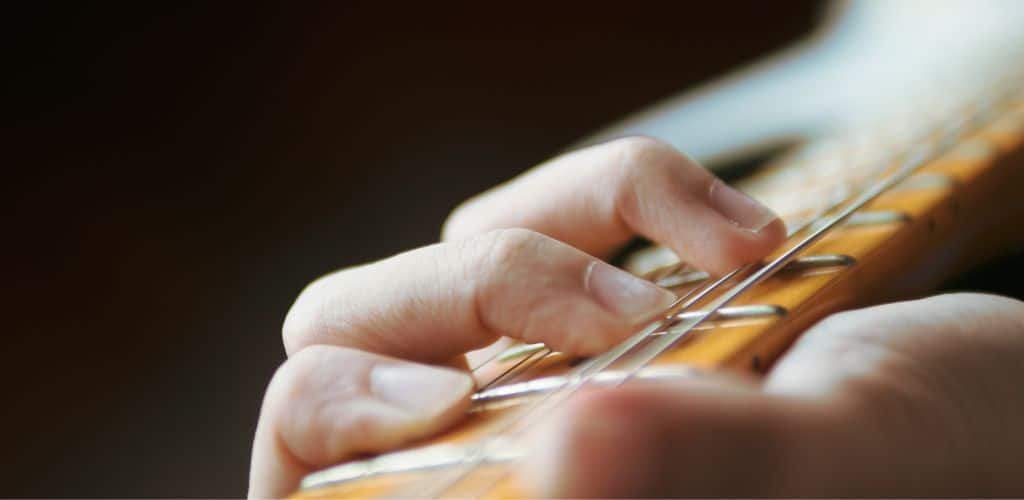Are you struggling to make your guitar playing more than just a series of awkward finger-cramp sessions?
Here are 10 essential exercises that every guitarist needs to unlock their inner rock star and strum like a pro:

Warm-Up Routine
ONE
First things first, those fingers need to be ready for action. Warm-up exercises are your trusty sidekick here.
Running your hands under warm water can help loosen them. Stretch them out under the water—no external pressure is needed. This helps build finger dexterity and gets your fingers moving with ease; you’ll be ready for those complex chord shapes in no time.

Finger Gymnastics
TWO
Start with simple finger exercises like the 1, 2, 3, 4 drill. Place your fingers sequentially on the first four frets of each string. Move up and down the neck, maintaining precision.
Include the ring-pinkie hammer-on/pull-off combo. It’s a real finger workout. By doing this, you’ll increase finger independence, making intricate riffs child’s play.

Spider Walk
THREE
Start with your fingers on the 5th fret, each one on a different string—just like a sneaky spider. Crawl up and down the fretboard, one fret at a time. Keep your fingers spread out so you don’t accidentally touch other strings.
Mix in some hammer-ons and pull-offs. Climbing up the fretboard like Spiderman makes your fingers strong and fast. But watch out – if you slip, you might fall off the building!
Turn it into a game! Close your eyes and see if you can still land on the right frets.

Fretboard Note Memorization
FOUR
Know your fretboard like the back of your hand. Consistency is key.
Focus on fingerboard landmarks like the 5th and 12th frets. These spots often coincide with position shifts in common scales and songs. Practice moving to these spots seamlessly.
Slides and hammer-ons are your friends here. Use them to move between positions fluidly. These techniques will make your playing look effortless and your sound more dynamic.

Chord Switching
FIVE
Finger placement and strength are essential here. Start with basic open chords. Set a timer for two minutes to switch between chords smoothly. It’s like speed dating, but for guitarists.
To master barre chords, practice pressing all six strings with one finger, keeping your thumb aligned behind the fretboard for leverage. Slide chords along the neck to build finger strength and have fun. Play different songs to blend these chord changes until they feel natural seamlessly.

Strumming Patterns
SIX
Strumming patterns often involve a mix of downstrokes and upstrokes. It’s the guitar equivalent of patting your head and rubbing your belly simultaneously. Many beginners struggle with getting the down-up motion right.
The key to mastering strumming patterns is developing muscle memory. Start with basic patterns like down-down-up-down-up, saying the pattern aloud before playing to internalize the rhythm and lay a solid foundation.

Scale Sequences
SEVEN
The A minor pentatonic scale is a beginner’s best mate. It’s like a trusty GPS guiding your fingers where they need to be.
One key exercise is to play scales slowly, using a metronome and gradually increasing speed to build muscle memory and maintain tune and rhythm. Spider crawls are brilliant for developing finger dexterity and independence. These exercises will make your fingers as agile as a well-trained army.

Arpeggio Drills
EIGHT
Fingerpicking has gone from a basic skill to a fancy art style. These are the two must-know fingerpicking tricks that every guitar player should have up their sleeve.
Pattern Picking: Pattern picking is all about following a set plan instead of randomly plucking strings, keeping a steady beat, and using the same fingers for the same strings every time.
Thumb (P): Handles the bass notes on the E, A, and D strings.
Index (I): Strums the G string.
Middle (M): Takes care of the B string.
Ring (A): Covers the high E string.
Travis Picking: Travis Picking, named after Merle Travis, is a classic style where your thumb keeps a steady bass line going while your index and middle fingers pluck out catchy tunes that dance around the beat.
Thumb: Alternates between bass strings, usually the E and A strings.
Index and Middle Fingers: Pluck the higher strings to create melody and harmony.

Finger Independence
NINE
Loud and soft guitar playing can profoundly affect a song’s emotion. Achieving this requires control over your strum hand and fret hand.
Strum lightly for softer sounds and gradually increase pressure for louder sounds. Pay attention to your fret hand and maintain an even grip. By practicing different volumes, you can add depth to your music.

Metronome Meditation
TEN
The metronome is a guitarist’s best friend. It keeps a steady beat and helps you match your notes to each click, making your timing spot-on.
If you hear any off-beat notes, slow down the tempo, feel the rhythm, and make sure every note fits perfectly with the beat – you’ll be playing in time in no time!
Try different speeds and slowly increase the tempo when using the metronome as you get more comfortable. It’s the easiest way to build rock-solid timing without breaking a sweat.

Korg MA-2 Metronome

COMES WITH: A Larger and more easily readable display
FEATURES: Timer, enhanced volume, and a useful 'sound-out' mode
Korg MA-2 Metronome
- Has a Tap Tempo function, making it super easy to use
- Earphone jack with adjustable volume
- Stylish display
- Compact - so easy to travel
- None!
When you click ‘Check Price’, you’ll see there are loads of great places to buy this item. Our personal favorite is Sweetwater for the US, and Thomann and Gear4Music for the UK & Europe.
They are the largest music retailers, with excellent customer service, competitive prices, really fast shipping, and the longest guarantees.
The professional musician who wrote this article combined many things,
from the product build, manufacturer’s reputation through to feedback
from other users, to create our famous TedScore™.
Putting It All Together:
Creative Consistency
Mastering guitar exercises is crucial, but blending those skills seamlessly is the key!
Create a practice routine packed with fun exercises. Start with finger tapping: place all four fingers of your left hand on adjacent frets.
Set a fixed practice duration each day. Start with 15-20 minutes and increase to 45-60 minutes as your fingers get accustomed. A regular schedule can help keep your practice sessions efficient and enjoyable.

Mix up your routines to keep things fresh. Alternating between different exercises ensures each session is exciting and beneficial.
Remember, consistency is key. Don’t just do these exercises once and call it a day. Make them part of your routine.
ERNIE BALL 2223 SUPER SLINKY

FEATURES: These Nickel Steel Strings Offer A Warm And Resonant Tone Even When The Guitar Is Not Plugged Into An Amp
OTHER INFO: STRING GAUGES: 0.09-0.42
- Clarity throughout the entire fretboard
- Highly versatile
- The nickel plated steel strings sound great without an amp
- Not the best option for guitarists who like a dark tone
When you click ‘Check Price’, you’ll see there are loads of great places to buy this item. Our personal favorite is Sweetwater for the US, and Thomann and Gear4Music for the UK & Europe.
They are the largest music retailers, with excellent customer service, competitive prices, really fast shipping, and the longest guarantees.
The professional musician who wrote this article combined many things,
from the product build, manufacturer’s reputation through to feedback
from other users, to create our famous TedScore™.
Fender Guitar Strap Cotton/Leather

PERFECT FOR: regular practice and performances
FEATURES: With adjustable length to ensure you find optimum comfort and precise playability
OTHER INFO: Made of durable nylon material
Fender Guitar Strap Cotton/Leather
- Reliable enough for the most demanding performance
- Expect to play with comfort and world-renowned Fender quality
- Gives the peace of mind you need to perform
- A little more expensive compared to other brands
When you click ‘Check Price’, you’ll see there are loads of great places to buy this item. Our personal favorite is Sweetwater for the US, and Thomann and Gear4Music for the UK & Europe.
They are the largest music retailers, with excellent customer service, competitive prices, really fast shipping, and the longest guarantees.
The professional musician who wrote this article combined many things,
from the product build, manufacturer’s reputation through to feedback
from other users, to create our famous TedScore™.











While I find the exercises on Finger Independence crucial, I believe that integrating more music theory into practice sessions can significantly enhance one’s understanding and execution of these drills. It’s one thing to be able to move fingers independently, but understanding why you’re moving them in that manner deeply enriches the learning process. Would love to see more theory-based explanations, Hugh Richardson.
Metronome Meditation, huh? Sounds like a fancy way to say ‘play in time’. Rock on, Emery.
I’ve been having trouble switching chords smoothly, as mentioned under Chord Switching in your article, Hugh Richardson. Is there a particular exercise you would recommend for a beginner who struggles with making transitions without pausing or producing a buzzing sound?
Hey TerryS, not Hugh Richardson, but I’ve found that practicing chord transitions slowly and then gradually increasing speed helped me a lot. Hope that helps!
Really enjoyed the section on scale sequences, Hugh Richardson. It’s given me a new practice direction. Thanks!